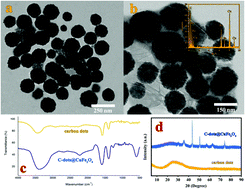An electrochemical sensor for the simultaneous determination of rifampicin and isoniazid using a C-dots@CuFe2O4 nanocomposite modified carbon paste electrode
Abstract
In this study, a sensitive carbon paste electrode based on a novel nanocomposite of carbon dots/CuFe2O4 (C-dots@CuFe2O4) was developed for the simultaneous determination of rifampicin (RIF) and isoniazid (INZ). The morphological and structural properties of the C-dots@CuFe2O4 were well characterized by transmission electron microscopy (TEM), Fourier transform infrared spectroscopy (FTIR) and X-ray diffraction (XRD). Under the optimized conditions, the voltammetric current increased linearly on increasing the concentration of RIF and INZ in the range of 0.07 to 8.0 and 0.1 to 14.0 μmol L−1, respectively. Moreover, the detection limits for the analytes were calculated to be 0.022 μmol L−1 for RIF and 0.041 μmol L−1 for INZ based on 3Sb/m. The practical applicability of the proposed sensor was examined by evaluating the detection of RIF and INZ in biological fluids and pharmaceutical samples with satisfactory recoveries. The C-dots@CuFe2O4/CPE can hold great promise for fast, simple and sensitive detection of RIF and INZ in various real samples.



 Please wait while we load your content...
Please wait while we load your content...